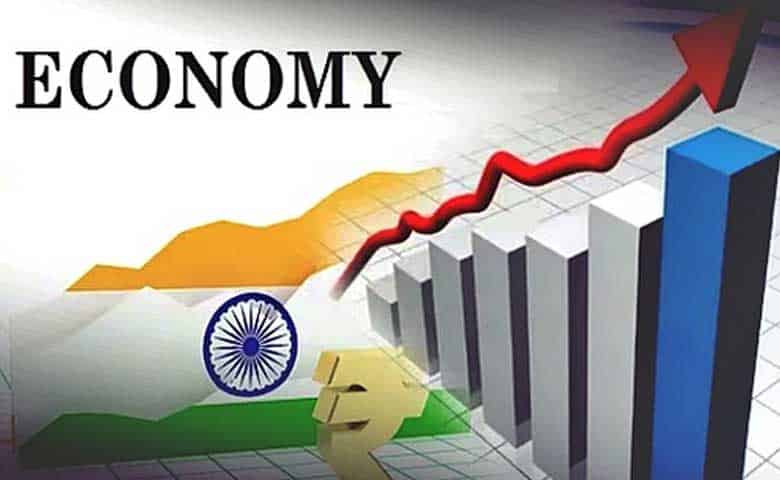India Set to Overtake Japan in GDP Ranking by 2025, Becoming World’s 4th-Largest Economy
India is on track to surpass Japan in gross domestic product (GDP) and become the world’s fourth-largest economy by 2025, according to a report in Japan Times.

New Delhi: India is on track to surpass Japan in gross domestic product (GDP) and become the world’s fourth-largest economy by 2025, according to a report in Japan Times.
This marks a significant milestone in India’s economic ascent, as it continues to emerge as a global economic powerhouse, surpassing the UK in GDP in 2022.
Also Read: Indian Stock Market Ends Flat; Gold Prices Continue to Trade Low
India’s Economic Rise: Forecast to Overtake Japan by 2025
The Japan Times article, which draws insights from economists including Marcel Thieliant, Head of Asia-Pacific at Capital Economics, highlights that India’s GDP could soon outpace Japan’s, securing a spot just behind the United States, China, and Germany. While earlier forecasts predicted this shift would occur in 2026, economists have revised their predictions in light of recent economic developments. The International Monetary Fund (IMF) now projects this transition to happen as soon as 2025.
India’s nominal GDP is expected to reach $4.339 trillion by 2025, slightly surpassing Japan’s $4.310 trillion, according to the IMF. This rapid growth trajectory underscores India’s expanding economic influence on the global stage.
Factors Driving India’s Economic Growth
India’s rise is being fueled by several key factors, including its young and growing population, increasing participation in global trade, and significant strides in digital transactions. Since the early 2000s, India’s economy has steadily expanded, benefiting from structural reforms, investments in infrastructure, and a rapidly growing tech sector.
India’s shift toward using the rupee in trade with 27 countries, instead of relying on the US dollar, demonstrates its growing influence in global commerce. Additionally, India now accounts for 46 percent of global digital transactions, further bolstering its position as a leader in the global economy.
India’s young demographics and expanding middle class are key drivers of its economic expansion. The country’s population is expected to remain a significant contributor to economic growth, providing a steady workforce for decades to come. This contrasts with Japan’s aging population, which has become a significant drag on its economic productivity.
Japan’s Economic Struggles
Japan, on the other hand, has been facing numerous economic challenges. The country has struggled with stagnation, recurring recessions, and deflation for decades. A major factor behind Japan’s slow economic growth is its aging population, with fewer people entering the workforce and rising healthcare costs putting pressure on the economy.
Japan’s GDP growth was sluggish in 2023, with a growth rate of just 1.9 percent. The IMF forecasts even slower growth of just 0.3 percent in 2024. In comparison, India’s economy is projected to grow at a significantly higher rate. Additionally, Japan’s productivity levels have remained low in many sectors, and its struggle with digitalization and structural reforms has hindered its ability to compete with rapidly developing nations like India.
Japan’s currency, the yen, has also weakened in recent years, further impacting its global economic standing. These factors combined have allowed India to steadily close the gap with Japan, paving the way for India to overtake Japan in GDP rankings.
India’s Increasing Geopolitical Influence
India’s economic growth is also accompanied by its rising geopolitical stature. The country has become an influential player in multilateral diplomacy, global security, and regional power dynamics. India recently surpassed Japan to become the third-largest power in the Asia Power Index, reflecting its growing influence in the region.
India’s economic ascent is mirrored by its increasing military capabilities, diplomatic clout, and strategic partnerships. As India continues to strengthen its position as a global power, its role in shaping international policies and economic trends will likely expand, further consolidating its position as a key player in the 21st-century global economy.
What This Means for India’s Future
India’s anticipated rise to the fourth-largest economy in the world by 2025 is a testament to its economic resilience and growth potential. The country’s young population, technological advancements, and expanding global trade relationships provide a solid foundation for continued economic progress.
As India’s economic influence grows, it is also poised to reshape the global economic order, challenging established economic powers and pushing for greater representation of emerging economies in global forums. The shift in GDP rankings is more than just a numerical change; it signals India’s growing role as a central force in shaping the future of global economics and geopolitics.
Key Takeaways:
- India’s GDP forecast to surpass Japan: The IMF projects India’s nominal GDP will hit $4.339 trillion by 2025, surpassing Japan’s $4.310 trillion.
- Growth drivers: India’s young population, digital economy, and growing trade relationships are key factors fueling its economic rise.
- Challenges for Japan: Japan’s aging population, low productivity, and economic stagnation are hindering its growth potential.
- India’s geopolitical influence: India’s economic ascent is complemented by its growing geopolitical and military power in Asia and beyond.
- Global economic shift: India’s rise signals a shift in global economic dynamics, as emerging economies like India gain influence.
Conclusion
India’s economic trajectory is rapidly changing the global landscape, with the country set to overtake Japan in GDP rankings by 2025. This shift underscores India’s growing influence on the world stage, driven by strong demographic trends, technological advancements, and strategic global partnerships. As India moves towards becoming the world’s fourth-largest economy, it is poised to shape the future of global trade, finance, and geopolitics.
